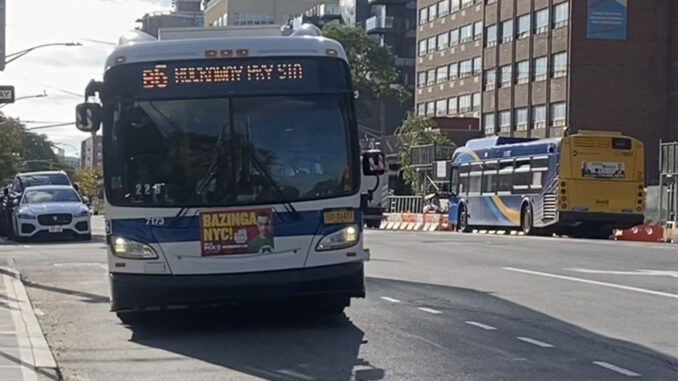
By Yacetie Santos
Why can’t taking the B6 after class ever be a peaceful and wholesome experience? The moment you see the bus approaching the bench at Bedford Avenue/Campus Road just outside Brooklyn College, you sense the strain in its uneven gait and labored braking. It’s full. Too full. People are packed so tightly that you can discern what they’ve had for lunch. Even the hiss it emits as it shakily kneels feels like a very tired animal pushed beyond its limits.
As a frequent B6 rider, I’ve noticed an air of hostility permeating each bus ride. Communal transport should be a shared space for people to commute to and from work and school, and it should show consideration for the elderly, disabled, and pregnant. Yet, when you’re standing side by side, swaying into fellow passengers by the will of the titanium beast and the beast-driver, there arises an inhospitable atmosphere in which no one belongs, and no one thinks anyone else belongs either. You’re simultaneously in everyone’s personal space, and everyone’s in yours. You’re stepping on feet, scrunching into yourself, and heaven forbid you wear a bookbag!
The other day, while I was riding the bus after school, two men began screaming at each other over the heads of fellow passengers. This particular B6 wasn’t a limited bus, and for the 40-minute drive to Rockaway Parkway station in Canarsie, these two men yelled, insulted, and nearly came to blows twice – all over a seat. This exchange continued, each exclamation escalating the fight until it earned the official New Yorker look of disapproval from other passengers.
Sabrina Peguero, a student at BC, recounted an aggressive interaction we both witnessed on the B6 two semesters ago. “When we were on the bus together, there was a guy screaming and yelling, talking to the bus driver, asking why he’s driving slow,” she said. “He got up in the driver’s face, and the bus driver threatened to get the police involved. Everyone was staring at him and feeling uncomfortable. I felt like he was probably going to do something like hit the bus driver. Everyone was quiet, just waiting to see what he did next.”
This aggression isn’t limited to inter-passenger conflict; it affects drivers, as well. Assaults on bus drivers have increased by 36%, and spitting incidents are up by 21%, as reported by NBC New York. This has led to the initiative to implement cubicle partitions for bus drivers, limiting their interactions with passengers. While this policy prioritizes driver safety, it further highlights the increasingly asocial nature of public transportation.
So, is the lack of space the sole source of this hostility? The actual bus route to Rockaway station from campus is populated with schools. Not only are we college students taking the bus, but so are the students of Midwood High School, P.S. 152, and South Shore High School. The B6 lines transport a significant number of students each weekday, adding to the stress and hostility of the bus ride.
Seating in transit defines personal space, providing a sense of privacy. When there’s no seating, defined standing space becomes your private bubble of personal space. However, as more passengers board, that bubble shrinks, and you’re surrounded by bodies. Many B6 buses can’t stop at scheduled stops because they can’t fit any more passengers inside.
Many people have submitted to the culture of entering buses through the back door, or as I like to call it, “back-door hopping;” desperate times call for desperate measures. Initially a precaution to protect drivers, it became a fare-evasion tactic. This quick, easy, and free method of boarding significantly contributes to buses filling up rapidly.
On off days, the drivers’ usual apathy about the tactic turns into annoyance, verbalized only through tired looks and muttering. On worse days, that annoyance becomes confrontation, sometimes closing the doors on passengers who back-door hop or passive-aggressively announcing that the only viable entrance is through the front. Confrontation on public transit very often veers into escalation, and this all adds to overall bus aggression.
Aaliah Hamilton Gibbons, another student at BC, ran the calculations with me. “$2.90, twice a day, Monday through Friday. So five days a week? After a month, that’s like 116 dollars for fare […]”, she paused, “[…] we have school nine months out of the year.”
If CUNY wants to strive for an accessible education for all, then how you get to school is absolutely their business. No barrier, especially one as trivial as a $2.90 bus fare, should stand in the way of your education. Further, the bus ride you take to get to school and to go home should not be one that is draining or hostile. Those moments before and after you get to school while you travel can set the tone around your education. In the best of times, they can reassure you that there is a strong, bonded community in and around the Brooklyn College campus. We are all on our separate journeys, but we don’t have to feel so far away while we are squished together.
Maybe a nurturing and wholesome environment on the B6 is possible, but it will take work. We must advocate for student needs; free bus fare is only one of many steps to creating accessibility for all Brooklyn College students.
